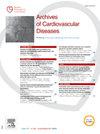Prognostic Value of Body Mass Index and Waist Circumference in Patients With Chronic Heart Failure: Algerian experience
IF 2.3
3区 医学
Q2 CARDIAC & CARDIOVASCULAR SYSTEMS
引用次数: 0
Abstract
Introduction
To analyze the association between higher body mass index and waist circumference, and the prognostic values of both indicators in total and cardiac mortality in patients with chronic heart failure.
Objective
To analyze the association between higher body mass index and waist circumference, and the prognostic values of both indicators in total and cardiac mortality in patients with chronic heart failure.
Method
The study included 1954 patients who were followed up for 4 years in military hospitals of Algeria. Obesity was classified as a body mass index > 30 and overweight as a body mass index of 25.0–29.9. Central obesity was defined as waist circumference > 88 cm for women and > 102 cm for men. Independent predictors of total and cardiac mortality were assessed in a multivariate Cox model adjusted for confounding variables.
Results
Obesity was present in 38% of patients, overweight in 46%, and central obesity in 63%. Body mass index and waist circumference were independent predictors of lower total mortality: hazard ratio = 0.84 (P < .001) and hazard ratio = 0.97 (P = .01), respectively, and lower cardiac death (body mass index, hazard ratio = 0.84, P < .001; waist circumference, hazard ratio = 0.97, P = .01). The interaction between body mass index and waist circumference (hazard ratio = 1.001, P < .01) showed that the protective effect of body mass index was lost in patients with a waist circumference > 120 cm.
Conclusion
Mortality was significantly lower in patients with a high body mass index and waist circumference. The results also showed that this protection was lost when these indicators over a certain limit.
体重指数和腰围在慢性心力衰竭患者中的预后价值:阿尔及利亚经验
前言:分析高体重指数与腰围的相关性,以及这两项指标在慢性心力衰竭患者总死亡率和心源性死亡率中的预后价值。目的分析高体重指数与腰围的相关性,以及两者在慢性心力衰竭患者总死亡率和心源性死亡率中的预测价值。方法对阿尔及利亚军队医院收治的1954例患者进行4年随访。肥胖被归类为身体质量指数>;体重指数为25.0-29.9。中心性肥胖被定义为腰围>;88厘米的女性和>;男性102厘米。总死亡率和心脏死亡率的独立预测因子在校正混杂变量的多变量Cox模型中进行评估。结果38%的患者存在肥胖,46%的患者存在超重,63%的患者存在中心性肥胖。体重指数和腰围是降低总死亡率的独立预测因子:危险比= 0.84 (P <;.001),风险比= 0.97 (P = 0.01),心脏死亡率降低(体重指数,风险比= 0.84,P <;措施;腰围,风险比= 0.97,P = 0.01)。体重指数与腰围的交互作用(风险比= 1.001,P <;.01)表明体重指数的保护作用在腰围< gt的患者中消失;120厘米。结论高体重指数、高腰围患者的死亡率明显较低。结果还表明,当这些指标超过一定限度时,这种保护作用就会消失。
本文章由计算机程序翻译,如有差异,请以英文原文为准。
求助全文
约1分钟内获得全文
求助全文
来源期刊

Archives of Cardiovascular Diseases
医学-心血管系统
CiteScore
4.40
自引率
6.70%
发文量
87
审稿时长
34 days
期刊介绍:
The Journal publishes original peer-reviewed clinical and research articles, epidemiological studies, new methodological clinical approaches, review articles and editorials. Topics covered include coronary artery and valve diseases, interventional and pediatric cardiology, cardiovascular surgery, cardiomyopathy and heart failure, arrhythmias and stimulation, cardiovascular imaging, vascular medicine and hypertension, epidemiology and risk factors, and large multicenter studies. Archives of Cardiovascular Diseases also publishes abstracts of papers presented at the annual sessions of the Journées Européennes de la Société Française de Cardiologie and the guidelines edited by the French Society of Cardiology.
 求助内容:
求助内容: 应助结果提醒方式:
应助结果提醒方式:


